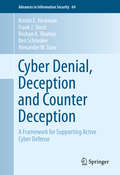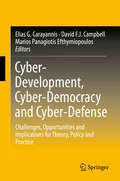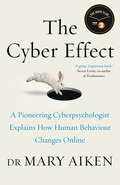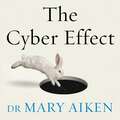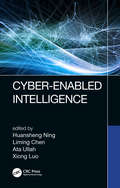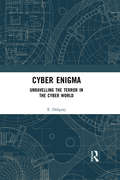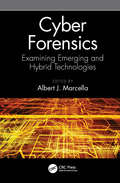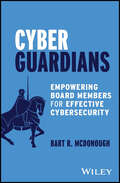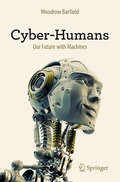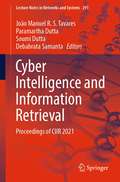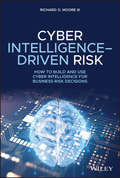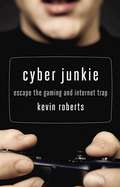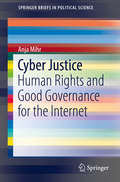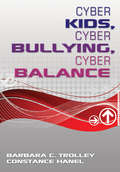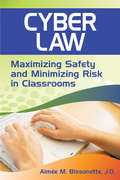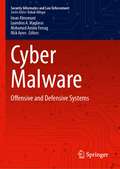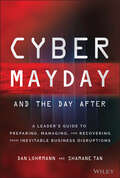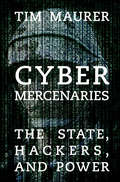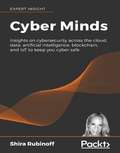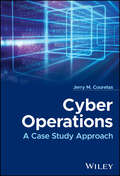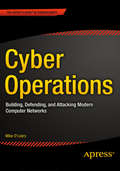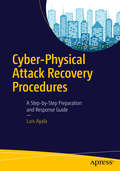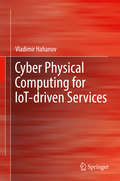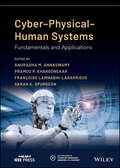- Table View
- List View
Cyber Denial, Deception and Counter Deception: A Framework for Supporting Active Cyber Defense (Advances in Information Security #64)
by Kristin E. Heckman Frank J. Stech Roshan K. Thomas Ben Schmoker Alexander W. TsowThis book presents the first reference exposition of the Cyber-Deception Chain: a flexible planning and execution framework for creating tactical, operational, or strategic deceptions. This methodology bridges the gap between the current uncoordinated patchwork of tactical denial and deception (D&D) techniques and their orchestration in service of an organization's mission. Concepts for cyber- D&D planning operations and management are detailed within the larger organizational, business, and cyber defense context. It examines the necessity of a comprehensive, active cyber denial scheme. The authors explain the organizational implications of integrating D&D with a legacy cyber strategy, and discuss trade-offs, maturity models, and lifecycle management. Chapters present the primary challenges in using deception as part of a security strategy, and guides users through the steps to overcome common obstacles. Both revealing and concealing fact and fiction have a critical role in securing private information. Detailed case studies are included. Cyber Denial, Deception and Counter Deception is designed as a reference for professionals, researchers and government employees working in cybersecurity. Advanced-level students in computer science focused on security will also find this book useful as a reference or secondary text book.
Cyber-Development, Cyber-Democracy and Cyber-Defense: Challenges, Opportunities and Implications for Theory, Policy and Practice
by Elias G. Carayannis David F. J. Campbell Marios Panagiotis EfthymiopoulosIn this volume, contributors from academia, industry, and policy explore the inter-connections among economic development, socio-political democracy and defense and security in the context of a profound transformation, spurred by globalization and supported by the rapid development of information and communication technologies (ICT). This powerful combination of forces is changing the way we live and redefining the way companies conduct business and national governments pursue strategies of innovation, economic growth and diplomacy. Integrating theoretical frameworks, empirical research and case studies, the editors and contributors have organized the chapters into three major sections, focusing on cyber-development, cyber-democracy and cyber-defense. The authors define cyber-development as a set of tools, methodologies and practices that leverage ICT to catalyze and accelerate social, political and economic development, with an emphasis on making the transition to knowledge-based economies. One underlying understanding here is that knowledge, knowledge creation, knowledge production and knowledge application (innovation) behave as crucial drivers for enhancing democracy, society, and the economy. By promoting dissemination and sharing of knowledge, cyber-democracy allows a knowledge conversion of the local into the global (gloCal) and vice versa, resulting in a gloCal platform for communication and knowledge interaction and knowledge enhancement Meanwhile, technology-enabled interconnectivity increases the need to adopt new methods and actions for protection against existing threats and possible challenges to emerge in the future The final section contemplates themes of cyber-defense and security, as well as emerging theories and values, legal aspects and trans-continental links (NATO, international organizations and bilateral relations between states) Collectively, the authors present a unique collection of insights and perspectives on the challenges and opportunities inspired by connectivity.
The Cyber Effect: A Pioneering Cyberpsychologist Explains How Human Behaviour Changes Online
by Mary AikenDr Mary Aiken is the world's leading expert in forensic cyberpsychology - a discipline that combines psychology, criminology and technology to investigate the intersection between technology and human behaviour. In this, her first book, Aiken has created a starting point for all future conversations about how the Internet is shaping our perception of the world, development and behaviour, societal norms and values, children, safety and security.Covering everything from the impact of screens on the developing child to the explosion of teen sexting, and the acceleration of compulsive and addictive online behaviours (gaming, shopping, pornography), The Cyber Effect also examines the escalation in cyberchondria (self-diagnosis online), cyberstalking and organized crime in the Deep Web. Cyberspace is an environment full of surveillance, but who is looking out for us? Full of surprising statistics and incredible-but-true case studies of the hidden trends that are shaping our culture, this book raises troubling questions about where the digital revolution is taking us.Upending your assumptions about your online life and forever changing the way you think about the technology that you, your friends and your family use, The Cyber Effect offers a fascinating and chilling look at a future we can still do something about.
The Cyber Effect: A Pioneering Cyberpsychologist Explains How Human Behaviour Changes Online
by Mary AikenFrom the world's leading expert in forensic cyberpsychology - a discipline that combines psychology, forensics and technology - comes a groundbreaking exploration of the impact of technology on human behaviour. The average person now checks their phone over 200 times a day. That's a serious addiction - but because we're all doing it all the time, it doesn't seem quite so scary. And, like all addicts, we have avoided thinking about the implications of the cyber effect. But now, at last, there is someone who can explain what is happening to us, how it works and what we can do about it. In this, the first book of its kind, Dr Mary Aiken applies her expertise in cyber-behavioural analysis to a range of subjects including criminal activity on the Deep Web and Darknet; deviant behaviour; internet addictions; the impact of technology on the developing child; teenagers and the Web; cyber romance and cyber friendships; cyberchrondria; the future of artificial intelligence; and the positive effects on our digital selves, such as online altruism. Packed with vivid stories, eye-opening insights and surprising statistics, The Cyber Effect offers us a fascinating guide through a new future that it's not too late to do something about.(P) 2016 Penguin Random House Audio
Cyber-Enabled Intelligence
by Liming Chen Huansheng Ning Ata Ullah Xiong LuoThe book provides an advanced vision and trends of computational intelligence in cyberspace and cyber-enabled spaces. It reviews architectures and models, as well as state-of-the-art computational and interpretation capabilities for social, industrial, and multimedia applications. Cyber-enabled intelligence involves the design and development of intelligent and innovative application scenarios in social networks, computer vision, multimedia, and image processing. Application scenarios can also cover the applicability of intelligent sensing, data collection and predictive analysis in Internet of Things.
Cyber Enigma: Unravelling the Terror in the Cyber World
by E. DiliprajCyber and its related technologies such as the Internet was introduced to the world only in late 1980s, and today it is unimaginable to think of a life without it. Despite being ubiquitous, cyber technology is still seen as an enigma by many, mainly due to its rapid development and the high level of science involved. In addition to the existing complexities of the technology, the level of threat matrix surrounding the cyber domain further leads to various misconceptions and exaggerations. Cyber technology is the future, thus forcing us to understand this complex domain to survive and evolve as technological beings. To understand the enigma, the book analyzes and disentangles the issues related to cyber technology. The author unravels the threats that terrorize the cyber world and aims to decrypt its domain. It also presents the existing reality of cyber environment in India and charts out a few recommendations for enhancing the country’s cyber security architecture. Further, the book delves into detailed analysis of various issues like hacking, dark web, cyber enabled terrorism and covert cyber capabilities of countries like the US and China. Please note: Taylor & Francis does not sell or distribute the Hardback in India, Pakistan, Nepal, Bhutan, Bangladesh and Sri Lanka
Cyber Forensics: Examining Emerging and Hybrid Technologies
by Albert J. MarcellaThreat actors, be they cyber criminals, terrorists, hacktivists or disgruntled employees, are employing sophisticated attack techniques and anti-forensics tools to cover their attacks and breach attempts. As emerging and hybrid technologies continue to influence daily business decisions, the proactive use of cyber forensics to better assess the risks that the exploitation of these technologies pose to enterprise-wide operations is rapidly becoming a strategic business objective. This book moves beyond the typical, technical approach to discussing cyber forensics processes and procedures. Instead, the authors examine how cyber forensics can be applied to identifying, collecting, and examining evidential data from emerging and hybrid technologies, while taking steps to proactively manage the influence and impact, as well as the policy and governance aspects of these technologies and their effect on business operations. A world-class team of cyber forensics researchers, investigators, practitioners and law enforcement professionals have come together to provide the reader with insights and recommendations into the proactive application of cyber forensic methodologies and procedures to both protect data and to identify digital evidence related to the misuse of these data. This book is an essential guide for both the technical and non-technical executive, manager, attorney, auditor, and general practitioner who is seeking an authoritative source on how cyber forensics may be applied to both evidential data collection and to proactively managing today’s and tomorrow’s emerging and hybrid technologies. The book will also serve as a primary or supplemental text in both under- and post-graduate academic programs addressing information, operational and emerging technologies, cyber forensics, networks, cloud computing and cybersecurity.
Cyber Guardians: Empowering Board Members for Effective Cybersecurity
by Bart R. McDonoughA comprehensive overview for directors aiming to meet their cybersecurity responsibilities In Cyber Guardians: Empowering Board Members for Effective Cybersecurity, veteran cybersecurity advisor Bart McDonough delivers a comprehensive and hands-on roadmap to effective cybersecurity oversight for directors and board members at organizations of all sizes. The author includes real-world case studies, examples, frameworks, and blueprints that address relevant cybersecurity risks, including the industrialized ransomware attacks so commonly found in today’s headlines. In the book, you’ll explore the modern cybersecurity landscape, legal and regulatory requirements, risk management and assessment techniques, and the specific role played by board members in developing and promoting a culture of cybersecurity. You’ll also find: Examples of cases in which board members failed to adhere to regulatory and legal requirements to notify the victims of data breaches about a cybersecurity incident and the consequences they faced as a result Specific and actional cybersecurity implementation strategies written for readers without a technical background What to do to prevent a cybersecurity incident, as well as how to respond should one occur in your organizationA practical and accessible resource for board members at firms of all shapes and sizes, Cyber Guardians is relevant across industries and sectors and a must-read guide for anyone with a stake in robust organizational cybersecurity.
Cyber-Humans: Our Future with Machines
by Woodrow BarfieldIt is predicted that robots will surpass human intelligence within the next fifty years. The ever increasing speed of advances in technology and neuroscience, coupled with the creation of super computers and enhanced body parts and artificial limbs, is paving the way for a merger of both human and machine. Devices which were once worn on the body are now being implanted into the body, and as a result, a class of true cyborgs, who are displaying a range of skills beyond those of normal humans-beings, are being created. There are cyborgs which can see colour by hearing sound, others have the ability to detect magnetic fields, some are equipped with telephoto lenses to aid their vision or implanted computers to monitor their heart, and some use thought to communicate with a computer or to manipulate a robotic arm. This is not science-fiction, these are developments that are really happening now, and will continue to develop in the future. However, a range of legal and policy questions has arisen alongside this rise of artificial intelligence. Cyber-Humans provides a deep and unique perspective on the technological future of humanity, and describes how law and policy will be particularly relevant in creating a fair and equal society and protecting the liberties of different life forms which will emerge in the 21st century. Dr Woodrow (Woody) Barfield previously headed up the Sensory Engineering Laboratory, holding the position of Industrial and Systems Engineering Professor at the University of Washington. His research revolves around the design and use of wearable computers and augmented reality systems and holds both JD and LLM degrees in intellectual property law and policy. He has published over 350 articles and major presentations in the areas of computer science, engineering and law. He currently lives in Chapel Hill, NC, USA.
Cyber Intelligence and Information Retrieval: Proceedings of CIIR 2021 (Lecture Notes in Networks and Systems #291)
by João Manuel R. S. Tavares Paramartha Dutta Soumi Dutta Debabrata SamantaThis book gathers a collection of high-quality peer-reviewed research papers presented at International Conference on Cyber Intelligence and Information Retrieval (CIIR 2021), held at Institute of Engineering & Management, Kolkata, India during 20–21 May 2021. The book covers research papers in the field of privacy and security in the cloud, data loss prevention and recovery, high-performance networks, network security and cryptography, image and signal processing, artificial immune systems, information and network security, data science techniques and applications, data warehousing and data mining, data mining in dynamic environment, higher-order neural computing, rough set and fuzzy set theory, and nature-inspired computing techniques.
Cyber Intelligence-Driven Risk: How to Build and Use Cyber Intelligence for Business Risk Decisions
by Richard O. Moore IIITurn cyber intelligence into meaningful business decisions and reduce losses from cyber events Cyber Intelligence-Driven Risk provides a solution to one of the most pressing issues that executives and risk managers face: How can we weave information security into our business decisions to minimize overall business risk? In today's complex digital landscape, business decisions and cyber event responses have implications for information security that high-level actors may be unable to foresee. What we need is a cybersecurity command center capable of delivering, not just data, but concise, meaningful interpretations that allow us to make informed decisions. Building, buying, or outsourcing a CI-DR™ program is the answer. In his work with executives at leading financial organizations and with the U.S. military, author Richard O. Moore III has tested and proven this next-level approach to Intelligence and Risk. This book is a guide to: Building, buying, or outsourcing a cyber intelligence–driven risk program Understanding the functional capabilities needed to sustain the program Using cyber intelligence to support Enterprise Risk Management Reducing loss from cyber events by building new organizational capacities Supporting mergers and acquisitions with predictive analytics Each function of a well-designed cyber intelligence-driven risk program can support informed business decisions in the era of increased complexity and emergent cyber threats.
Cyber Ireland
by Claire LynchCyber Ireland explores, for the first time, the presence and significance of cyberculture in Irish literature. Bringing together such varied themes as Celtic mythology in video games, Joycean hypertexts and virtual reality Irish tourism, the book introduces a new strand of Irish studies for the twenty-first century.
Cyber Junkie: Escape the Gaming and Internet Trap
by Kevin RobertsVideo gaming and Internet surfing are the top sources of entertainment for tens of millions of North Americans today. As these technologies continue to grow and flourish, so does the number of people becoming obsessively absorbed in the imagination and fantasy that they present. More and more people are isolating themselves, turning their backs on reality, ignoring family and friends, and losing sleep and even their jobs due to excessive use of video games and the Internet, and they continue to do so despite harmful consequences to their mental, physical, and spiritual health, a telltale sign of addiction. In this groundbreaking book, recovering video game addict Kevin Roberts uses extensive scientific and social research, complemented by his and others' personal stories, to give compulsive gamers and surfers--and their family and friends--a step-by-step guide for recovery. He outlines the ways that 'cyber junkies' exhibit the classic signs of addiction and reveals how they can successfully recover by following a program similar to those used for other addictions. Readers learn to identify whether they have an addiction, find the right resources to get individualized help, and regain a rewarding life away from the screen by learning new thoughts and behaviors that free them from the cravings that rule their lives. Included is a guide for parents for working with their addicted children. Kevin Roberts is a recovering video game addict who runs support groups to help others struggling with cyber addiction get their lives back on track. He is a nationally recognized expert on video gaming addiction and a regular conference speaker. Roberts has a background in education and is the developer of a sixteen-module curriculum designed to give those with attention deficit/hyperactivity disorder (ADHD), often a driving factor of video game and internet addiction, the skills they need to succeed. Cyber Junkie is his first book.
Cyber Justice: Human Rights and Good Governance for the Internet (SpringerBriefs in Political Science)
by Anja MihrThis book introduces Cyber Justice as a viable approach for promoting good governance based on human rights norms in the internet. The author defines cyberspace as a borderless public space without common rules or government control mechanisms that protect and foster people's activities within that space. In light of the growing scope of communications and interactions in the internet, the author shows how human rights and governance regimes can be adapted to cyberspace in order to ensure more accountability, transparency and interaction among those who use the internet and those who manage and provide internet services. This book will be of interest for scholars and policymakers interested in establishing governance regimes for cyberspace that will enjoy the support and trust of all users.
Cyber Kids, Cyber Bullying, Cyber Balance
by Constance Hanel Barbara C. TrolleyEmphasizing prevention, assessment, and evaluation, this proactive guide shows how to advance learning, reduce cyber bullying, and improve school climate by helping students use technology responsibly.
Cyber Law: Maximizing Safety and Minimizing Risk in Classrooms
by Aimee M. BissonetteAn essential overview of legal issues related to technology, this resource provides case summaries and proactive strategies on privacy, security, copyright, appropriate online behavior, and more.
Cyber Malware: Offensive and Defensive Systems (Security Informatics and Law Enforcement)
by Iman Almomani Leandros A. Maglaras Mohamed Amine Ferrag Nick AyresThis book provides the foundational aspects of malware attack vectors and appropriate defense mechanisms against malware. The book equips readers with the necessary knowledge and techniques to successfully lower the risk against emergent malware attacks. Topics cover protections against malware using machine learning algorithms, Blockchain and AI technologies, smart AI-based applications, automated detection-based AI tools, forensics tools, and much more. The authors discuss theoretical, technical, and practical issues related to cyber malware attacks and defense, making it ideal reading material for students, researchers, and developers.
Cyber Mayday and the Day After: A Leader's Guide to Preparing, Managing, and Recovering from Inevitable Business Disruptions
by Daniel Lohrmann Shamane TanSuccessfully lead your company through the worst crises with this first-hand look at emergency leadership Cyber security failures made for splashy headlines in recent years, giving us some of the most spectacular stories of the year. From the Solar Winds hack to the Colonial Pipeline ransomware event, these incidents highlighted the centrality of competent crisis leadership. Cyber Mayday and the Day After offers readers a roadmap to leading organizations through dramatic emergencies by mining the wisdom of C-level executives from around the globe. It’s loaded with interviews with managers and leaders who've been through the crucible and survived to tell the tale. From former FBI agents to Chief Information Security Officers, these leaders led their companies and agencies through the worst of times and share their hands-on wisdom. In this book, you’ll find out: What leaders wish they'd known before an emergency and how they've created a crisis game plan for future situations How executive-level media responses can maintain – or shatter – consumer and public trust in your firm How to use communication, coordination, teamwork, and partnerships with vendors and law enforcement to implement your crisis response Cyber Mayday and the Day After is a must-read experience that offers managers, executives, and other current or aspiring leaders a first-hand look at how to lead others through rapidly evolving crises.
Cyber Mercenaries: The State, Hackers, and Power
by Tim MaurerCyber Mercenaries explores the secretive relationships between states and hackers. As cyberspace has emerged as the new frontier for geopolitics, states have become entrepreneurial in their sponsorship, deployment, and exploitation of hackers as proxies to project power. Such modern-day mercenaries and privateers can impose significant harm undermining global security, stability, and human rights. These state-hacker relationships therefore raise important questions about the control, authority, and use of offensive cyber capabilities. While different countries pursue different models for their proxy relationships, they face the common challenge of balancing the benefits of these relationships with their costs and the potential risks of escalation. This book examines case studies in the United States, Iran, Syria, Russia, and China for the purpose of establishing a framework to better understand and manage the impact and risks of cyber proxies on global politics.
Cyber Minds: Insights on cybersecurity across the cloud, data, artificial intelligence, blockchain, and IoT to keep you cyber safe
by Shira RubinoffCyber Minds brings together an unrivalled panel of international experts who offer their insights into current cybersecurity issues in the military, business, and government. Key Features Explore the latest developments in cybersecurity Hear expert insight from the industry's top practitioners Dive deep into cyber threats in business, government, and military Book Description Shira Rubinoff's Cyber Minds brings together the top authorities in cybersecurity to discuss the emergent threats that face industries, societies, militaries, and governments today. With new technology threats, rising international tensions, and state-sponsored cyber attacks, cybersecurity is more important than ever. Cyber Minds serves as a strategic briefing on cybersecurity and data safety, collecting expert insights from sector security leaders, including: General Gregory Touhill, former Federal Chief Information Security Officer of the United States Kevin L. Jackson, CEO and Founder, GovCloud Mark Lynd, Digital Business Leader, NETSYNC Joseph Steinberg, Internet Security advisor and thought leader Jim Reavis, Co-Founder and CEO, Cloud Security Alliance Dr. Tom Kellerman, Chief Cybersecurity Officer for Carbon Black Inc and Vice Chair of Strategic Cyber Ventures Board Mary Ann Davidson, Chief Security Officer, Oracle Dr. Sally Eaves, Emergent Technology CTO, Global Strategy Advisor – Blockchain AI FinTech, Social Impact award winner, keynote speaker and author Dr. Guenther Dobrauz, Partner with PwC in Zurich and Leader of PwC Legal Switzerland Barmak Meftah, President, AT&T Cybersecurity Cleve Adams, CEO, Site 1001 (AI and big data based smart building company) Ann Johnson, Corporate Vice President – Cybersecurity Solutions Group, Microsoft Barbara Humpton, CEO, Siemens USA Businesses and states depend on effective cybersecurity. This book will help you to arm and inform yourself on what you need to know to keep your business – or your country – safe. What you will learn The threats and opportunities presented by AI How to mitigate social engineering and other human threats Developing cybersecurity strategies for the cloud Major data breaches, their causes, consequences, and key takeaways Blockchain applications for cybersecurity Implications of IoT and how to secure IoT services The role of security in cyberterrorism and state-sponsored cyber attacks Who this book is for This book is essential reading for business leaders, the C-Suite, board members, IT decision makers within an organization, and anyone with a responsibility for cybersecurity.
Cyber Operations: A Case Study Approach
by Jerry M. CouretasCyber Operations A rigorous new framework for understanding the world of the future Information technology is evolving at a truly revolutionary pace, creating with every passing year a more connected world with an ever-expanding digital footprint. Cyber technologies like voice-activated search, automated transport, and the Internet of Things are only broadening the interface between the personal and the online, which creates new challenges and new opportunities. Improving both user security and quality of life demands a rigorous, farsighted approach to cyber operations. Cyber Operations offers a groundbreaking contribution to this effort, departing from earlier works to offer a comprehensive, structured framework for analyzing cyber systems and their interactions. Drawing on operational examples and real-world case studies, it promises to provide both cyber security professionals and cyber technologies designers with the conceptual models and practical methodologies they need to succeed. Cyber Operations readers will also find: Detailed discussions of case studies including the 2016 United States Presidential Election, the Dragonfly Campaign, and more Coverage of cyber attack impacts ranging from the psychological to attacks on physical infrastructure Insight from an author with top-level experience in cyber security Cyber Operations is ideal for all technological professionals or policymakers looking to develop their understanding of cyber issues.
Cyber Operations
by Mike O'LearyCyber Operations walks you through all the processes to set up, defend, and attack computer networks. This book focuses on networks and real attacks, offers extensive coverage of offensive and defensive techniques, and is supported by a rich collection of exercises and resources.You'll learn how to configure your network from the ground up, starting by setting up your virtual test environment with basics like DNS and active directory, through common network services, and ending with complex web applications involving web servers and backend databases.Key defensive techniques are integrated throughout the exposition. You will develop situational awareness of your network and will build a complete defensive infrastructure—including log servers, network firewalls, web application firewalls, and intrusion detection systems.Of course, you cannot truly understand how to defend a network if you do not know how to attack it, so you will attack your test systems in a variety of ways beginning with elementary attacks against browsers and culminating with a case study of the compromise of a defended e-commerce site.The author, who has coached his university’s cyber defense team three times to the finals of the National Collegiate Cyber Defense Competition, provides a practical, hands-on approach to cyber security.
Cyber-Physical Attack Recovery Procedures: A Step-by-Step Preparation and Response Guide
by Luis AyalaThis book provides a template with step-by-step instructions on how to respond and recover when hackers get into your SCADA system and cause building equipment to act erratically or fail completely. When hackers shut off the water, turn off the building power, disable the sewage effluent pumps and activate the fire alarm, you have to do something quick. It is even more alarming that hackers can do all those things at the same time even from the other side of the planet. Not every equipment failure or power outage is a cyber-physical attack. When your building is attacked, you probably won t suspect it was a hacker until you see a pattern. The building control system (BCS) will act "squirrelly" and you will know it really is a cyber-physical attack. Once a cyber-physical attack occurs, it can mean years of court cases, job losses, higher insurance rates, and maybe even criminal litigation. It also takes years to overcome the loss of safety credibility to your employees and the local community. Cyber-Physical Attack Recovery Procedures provides a detailed guide to taking the right steps ahead of time, and equipping your facility and employees with the training, knowledge, and tools they need and may save lives. The book contains: A one-of-a-kind action plan describing how hackers attack building equipment, the extent of damage possible, and how to respond when a cyber-physical attack occurs. Detailed descriptions of cyber-physical attacks directed against SCADA systems or building controls, as well as cyber booby traps Invaluable appendices, including: Emergency Procedures, Team Staffing and Tasking, Alternate Site Procedures, a Documentation List, Software and Hardware Inventories, Vendor Contact Lists, External Support Agreements, and much more. What you ll learn Possible ways hackers can cause building equipment to fail. How to quickly assess the threat to his facilities in real time, how to stop a cyber-physical attack. How to restore equipment operation without doing any more damage. Who This Book Is For Architects, Engineers, Building Managers, Students, Researchers and Consultants interested in cybersecurity-attacks against facilities in the real world. Also for IT professionals getting involved in cybersecurity responsibilities. "
Cyber Physical Computing for IoT-driven Services
by Vladimir HahanovThis book presents the cyber culture of micro, macro, cosmological, and virtual computing. The book shows how these work to formulate, explain, and predict the current processes and phenomena monitoring and controlling technology in the physical and virtual space. The authors posit a basic proposal to transform description of the function truth table and structure adjacency matrix to a qubit vector that focuses on memory-driven computing based on logic parallel operations performance. The authors offer a metric for the measurement of processes and phenomena in a cyberspace, and also the architecture of logic associative computing for decision-making and big data analysis. The book outlines an innovative theory and practice of design, test, simulation, and diagnosis of digital systems based on the use of a qubit coverage-vector to describe the functional components and structures. Authors provide a description of the technology for SoC HDL-model diagnosis, based on Test Assertion Blocks Activated Graph. Examples of cyber-physical systems for digital monitoring and cloud management of social objects and transport are proposed. A presented automaton model of cosmological computing explains the cyclical and harmonious evolution of matter-energy essence, and also a space-time form of the Universe.
Cyber-Physical-Human Systems: Fundamentals and Applications (IEEE Press Series on Technology Management, Innovation, and Leadership)
by Anuradha M. Annaswamy Pramod P. Khargonekar Françoise Lamnabhi‐Lagarrigue Sarah K. SpurgeonCyber–Physical–Human Systems A comprehensive edited volume exploring the latest in the interactions between cyber–physical systems and humans In Cyber–Physical–Human Systems: Fundamentals and Applications, a team of distinguished researchers delivers a robust and up-to-date volume of contributions from leading researchers on Cyber–Physical–Human Systems, an emerging class of systems with increased interactions between cyber–physical, and human systems communicating with each other at various levels across space and time, so as to achieve desired performance related to human welfare, efficiency, and sustainability. The editors have focused on papers that address the power of emerging CPHS disciplines, all of which feature humans as an active component during cyber and physical interactions. Articles that span fundamental concepts and methods to various applications in engineering sectors of transportation, robotics, and healthcare and general socio-technical systems such as smart cities are featured. Together, these articles address challenges and opportunities that arise due to the emerging interactions between cyber–physical systems and humans, allowing readers to appreciate the intersection of cyber–physical system research and human behavior in large-scale systems. In the book, readers will also find: A thorough introduction to the fundamentals of cyber–physical–human systems In-depth discussions of cyber–physical–human systems with applications in transportation, robotics, and healthcare A comprehensive treatment of socio-technical systems, including social networks and smart cities Perfect for cyber–physical systems researchers, academics, and graduate students, Cyber–Physical–Human Systems: Fundamentals and Applications will also earn a place in the libraries of research and development professionals working in industry and government agencies.
